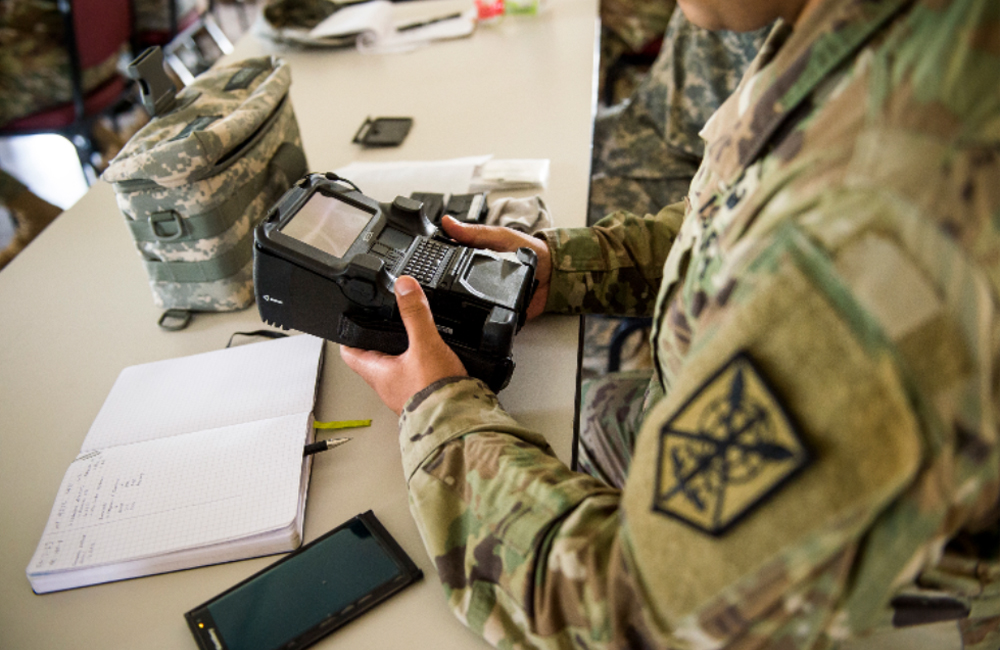The U.S. Army division that played a vital role in evacuating and vetting Afghan citizens from Kabul in August 2021 is modernizing its biometric data systems as one key effort ahead of the Defense Department’s Joint All Domain Command and Control (JADC2) concept.
Army Chief of Staff Gen. James McConville said JADC2 is “really about passing data, how quickly we can pass data” at a Defense Writers Group breakfast last week. “That’s really hard to do because our systems weren’t really designed to work together,” he added.
The Biometrics Program Office at Army’s Program Executive Office for Intelligence Electronic Warfare & Sensors (PEO IEW&S) is modernizing its systems to facilitate such data interoperability and sharpen data accuracy.
“As the U.S. government decided to close operations in Afghanistan, as the Afghan government started to collapse and the withdrawal effort [included] 130,000 [non-American] travelers, we were key in the efforts to vet those travelers before they came to the United States in ensuring there were no threats posed to us here,” Army PEO IEW&S Biometrics Program Manager Col. Senodja Sundiata-Walker told GovCIO Media & Research. “We had biometrics systems set up within some of the countries as ‘lily pad countries’ as travelers were moved into the U.S., and all those travelers were vetted through our system.”
This office worked with the State Department’s special visa program and the U.S. Citizenship and Immigration Services (USCIS) to move Afghans safely to the U.S.
“We used our near-real time identity intelligence system and voice and facial recognition,” Sundiata-Walker said. “Then as we started to assist with the actual retrograde of travelers, we used our BAT-A system (Biometrics Automated Toolset for the Army, which collects data from fingerprints and eyes). All of these collection systems feed back that data into ABIS (Automated Biometric Identification System) and that repository, which sits here in [the continental U.S. (CONUS)]. With the actual execution of that operation, travelers would come from different locations.”
The biometrics office’s success with the Afghan mission highlights the importance of identity intelligence to warfighter operations in theater and retrograde, and its future role in JADC2.
USCENTCOM currently uses the Near Real Time Identity Operations (NRTIO) system, which syncs with ABIS, to “enhance force protection and stem the flow of foreign fighters” in the Middle East, Egypt, Central Asia and parts of South Asia.
“That system can do biometric collection in under a minute,” Sundiata-Walker said. “We needed something much faster. They needed a go-no-go response faster than having to wait three minutes to go back into the repository within CONUS. It syncs with the ABIS system back here within CONUS very frequently so we have that information within theater.”
The Army originally launched ABIS to help identify bad actors and non-U.S. citizens who may be threats to DOD.
Sundiata-Walker said DOD’s ABIS fits into a “triad community” that includes the Department of Justice’s (DOJ) Next Generation Identification (NGI) system and DHS’ own Automated Biometric Identification System — formerly referred to as IDENT, to avoid confusion with DOD’s ABIS — which DHS recently modernized to the Homeland Advanced Recognition Technology (HART) system.
Each of the different biometrics programs serve their own functions — DOD focuses on national security, DHS on homeland security, and FBI on crime — but the three agencies can query each other’s systems through one common biometrics repository.
The 2021 National Defense Authorization Act (NDAA) added language to require biometric vetting of international military students coming to the U.S., in response to the 2019 shooting at the Naval Air Station Pensacola in Pensacola, Florida.
“That was an effort our office helped with to vet those students before they came so we ensured all the locations around the world had biometric collection devices to vet those students en route to the U.S.,” Sundiata-Walker said. “These aren’t frontline warfighters, these are foreign operations officers sitting at the embassies that now have the requirement to vet those students.”
Moving ABIS to the cloud, ironing out software wrinkles associated with the shift, and modernizing the outdated BAT-A system to interface more smoothly with ABIS are some of the biometrics office’s top priorities this year to get ready for JADC2.
“Moving to the cloud will help improve our access, the data sharing and the security that resides with having cloud access, to protect us from cyberattacks and the resiliency we need to continue our operations,” Sundiata-Walker said.
McConville envisions a JADC2 network where there isn’t only “one option” for passing mission-critical data, so if the network goes down, “there’s more than one way to pass that data.”
“You’re always worried about JADC2 because it’s network-dependent,” he said.
McConville also said the point of JADC2 is for different sensors and data-collection systems to use artificial intelligence “and quickly figure stuff out and pass it to the right lethal capability. It’s very, very important. That’s how you win. That, to me, is the secret of the future battlefield.”
That’s something the Army PEO IEW&S Biometrics Program Office wants to address. Sundiata-Walker said identity intelligence isn’t just about looking for terrorists, it’s also about using AI and biometrics in tandem to pinpoint enemies.
“The ability to identify and determine who is who out there on the battlefield is important,” she said. “As the intelligence community moves forward and looks at the order of battle, who are you fighting? If we were going into another war, you need to know exactly who is on the other side.”
To that end, one of the office’s modernization initiatives focuses on updating BAT-A, a legacy biometric data-collection sensor, to serve a more mobile environment.
The BAT-A system, which is a handheld device, is the “same brick size” as the first cellphones from the 1970s, Sundiata-Walker said.
“It was based on peripheral controls and made for function and not for size,” she said. “When I say we’re modernizing and it’s small enough to fit inside of a cargo pocket, that’s the future.”
Instead of phasing out this legacy system and spending more money on a new one, the biometrics office believes it can be revamped to suit modern DOD needs.
“What we’ve now shown the DOD is that, even a legacy system still has value,” Sundiata-Walker. “The importance of identity intelligence and superiority as it applies to information commanders and leaders need, to continue to protect us. Even though it has a legacy system, it has a very important mission here for us.”

















